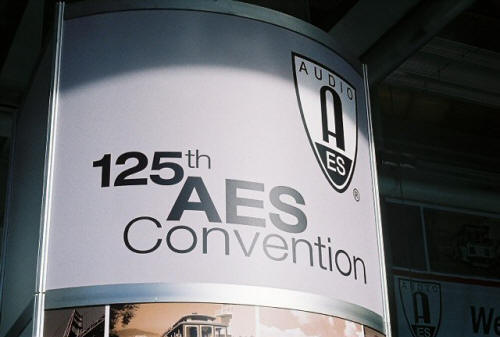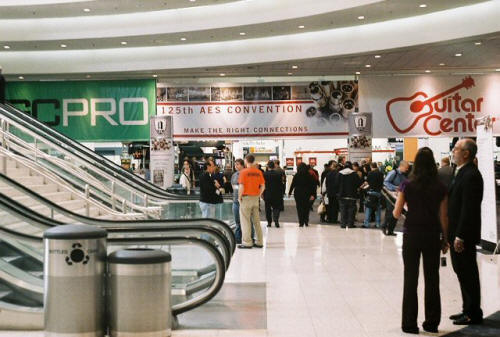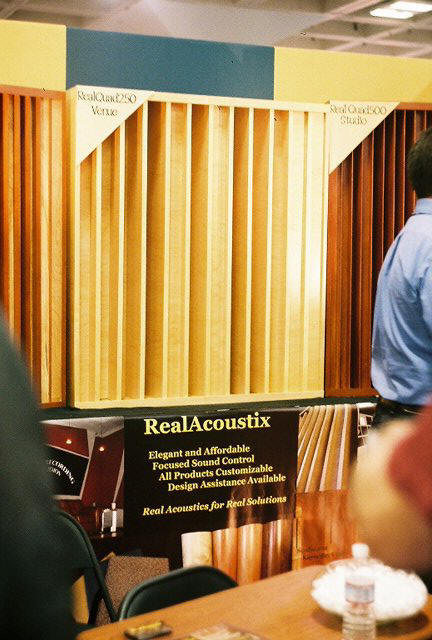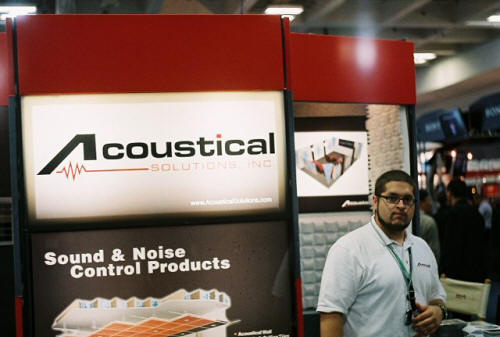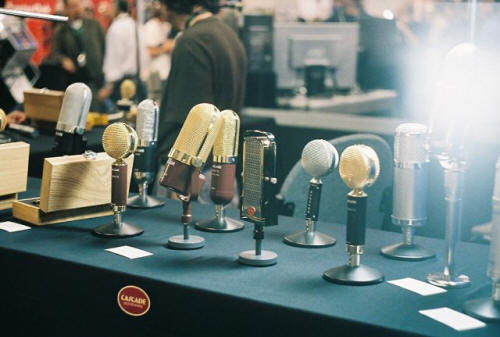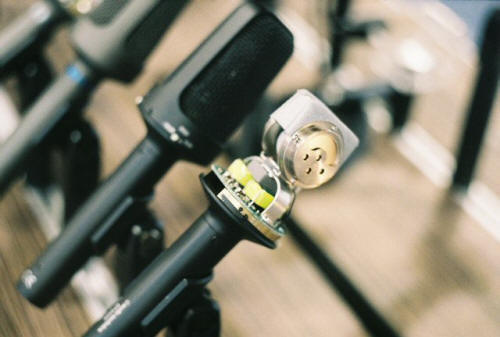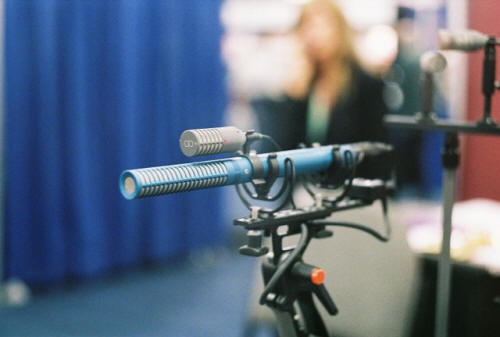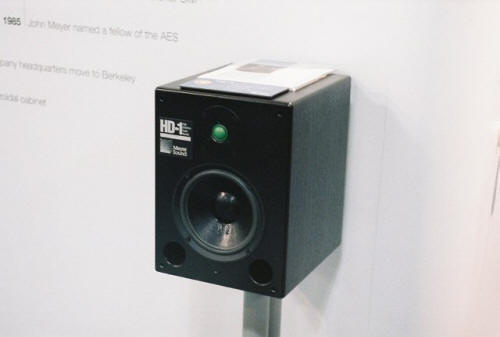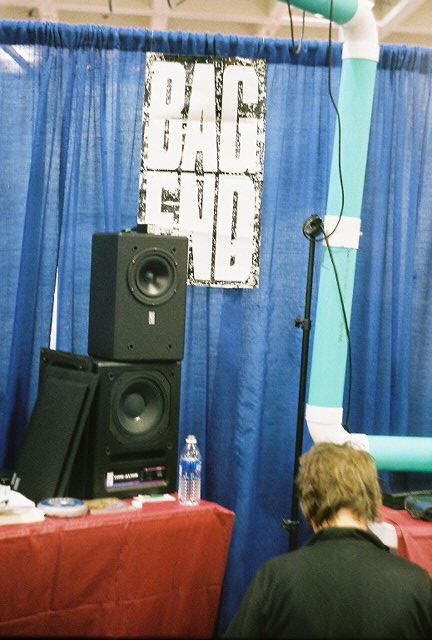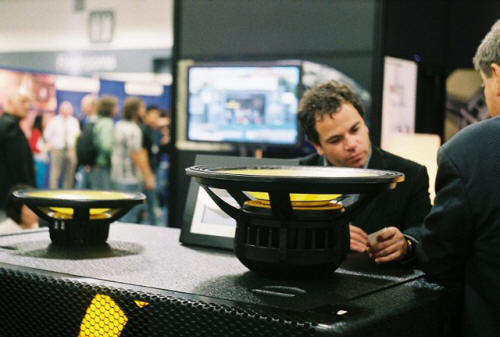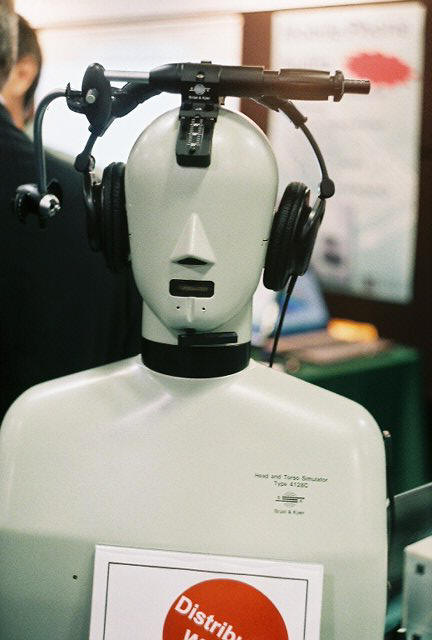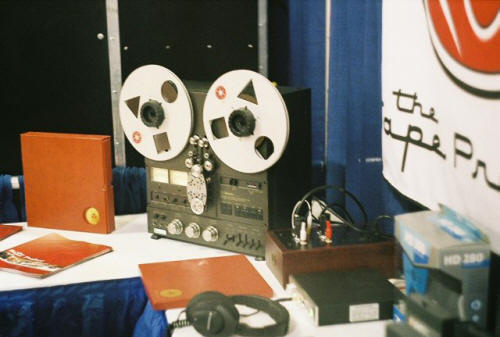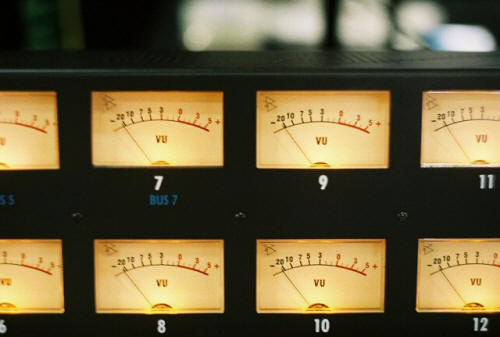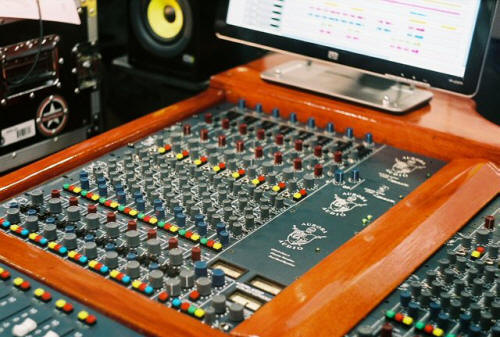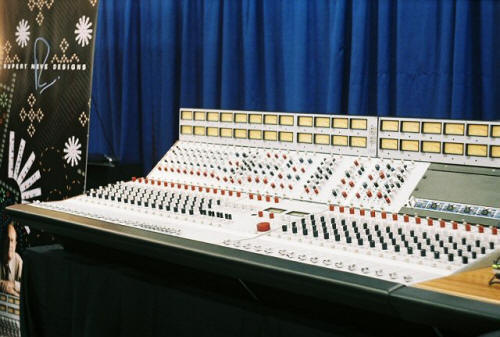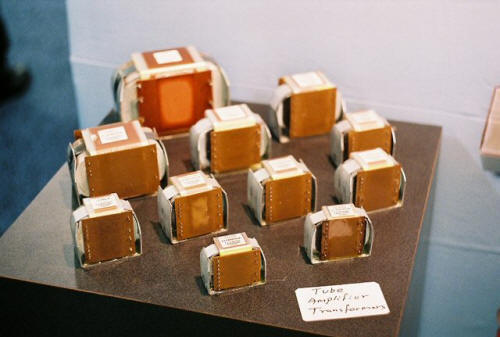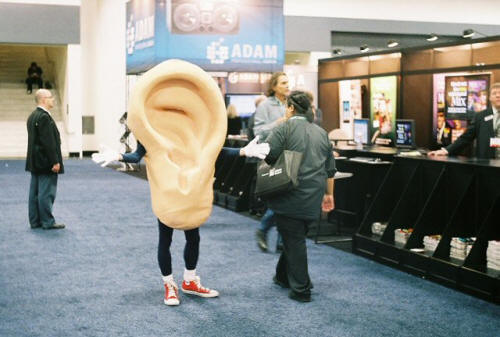|
You are reading the older HTML site Positive Feedback ISSUE 41january/february 2009
AES 2008
Introduction I always enjoy writing about a pro audio show for a high end audio audience, and this year was no exception. If anything, I think this year there was more of an interest in the whole minimalist audiophile ethos at the show and I think this is a good thing. Even so, there was still a large amount of cheap junk. If last year's big thing was everybody introducing electronic room tuning systems, I think this big thing this year was the huge number of large format recording consoles out on the show floor, a lot of them new. It's sure a big improvement. There were a lot of new microphones this year, a lot of new consoles, but not too much else that was tremendously new and innovative. A lot of the things that the pro audio press seemed to find important, like Roland taking over Sonar software products, didn't seem all that interesting to me and probably if you're reading Positive Feedback they won't seem all that interesting to you. So I left them out. This report is an overview of the things I saw at the show that I thought folks in the audiophile community might be interested in. It's by no means a complete list of all the products and papers at the show, and it's missing a lot of things that I would like to have seen but didn't have a chance to.
The AES show is actually two different events taking place in the same building: the trade show exhibits upstairs, and the standards and conference papers downstairs. I try and sample some of each and I never get a chance to see as much of either one as I'd like. So if your favorite paper or product didn't make this list, don't blame me. But do send me an email and tell me about it, especially if it's a thing I might have a chance to see at next year's show. And now... on to the show... Acoustical Treatment Both in the home listening room and in the studio, acoustical treatment and room configuration makes more of a difference than anything you can do with equipment. Unfortunately it's also one of the most neglected aspects of system design, in spite of giving you more for the dollar than just about any other.
Aaron Duncan and Matt Boughan from Acoustical Solutions in Richmond, Virginia were out showing off their line of absorbing and diffusing material. They make some very quality materials intended for everything from voiceover booths to auditoria, with a very wide range of characteristics. I was kind of sad that they did not have their acoustical banners available; the banners give you more absorption per dollar than anything else there. Mr. Duncan said that the banners were a hard sell in the studio world since they don't look particularly swanky, but I think with the poor economy these days they should be the first place to look for good wideband absorption. Auralex also had some people there. While Auralex has a smaller line of products, they are branching out a lot and they sell a lot more than just the foam they were originally famous for. What is most interesting is that they are now in the custom installation business as well, and they will provide a free custom room analysis given room dimensions, drawings, and photos. I think anyone interested in seeing what can be done to improve their room should look into this service. Bag End was showing their active bass trap, which is interesting and effective. It's more expensive but a lot smaller than an equally effective conventional passive bass trap, and the small size is a big deal in a lot of rooms these days. What was more interesting was they had a nifty demo built with a long PVC tube in order to demonstrate standing wave behaviour.
Everybody knows that you can't have the frequency response of a real room flat, but how flat is good enough? Bruno Fazenda and Matthew Wankling from the University of Huddersfield actually set out to measure it in "Optimal Modal Spacing and Density for Critical Listening". They simulated room resonances in software, played back samples in headphones to a listening panel, and developed some basic rules on the best compromises when moving room modes around. They found higher frequency modes and narrower modes were generally considered more problematic. They compared the perceived measurements with the measured MTF calculation of the room and found only rough agreement between them. They also found the spacing between room modes was really only important at the lowest frequencies. If you're curious about what else they found, check out preprint 7584. In "Estimating the Transfer Function from Air Conduction Recording to Ones Own Hearing", Sook Young Won and Johnathan Berger from Stanford gave a large body of undergraduates in both California and Korea recordings of their own voice and a filter bank, then asked them to adjust the filter bank so the recording sounded like what their own voice sounded like to them. From this they went on to estimate the transfer function of the portion of the voice that is heard by bone conduction when a person speaks. Everybody knows that their voice sounds different to themselves, but here is an attempt to actually quantify the effect. In my opinion, being able to quantify this can be a huge step toward improving the effectiveness of in-ear monitors for vocalists. Preprint 7630. When Sabin started measuring acoustical absorption a century ago, he first used an arbitrary unit that compared a given area of a test material with the same area of the cushions used in a particular auditorium in Harvard. Later on, he moved to the much more reasonable unit in which test materials are referenced to an area of open window. He originally did testing by adding absorption to a room and then measuring the change in reverb time, but this requires a lot of material to be added to a room. Today we mostly test small surfaces in an anechoic chamber, so that we don't have to fill a whole room up with a test material. In "In Situ Determination of Acoustic Absorption Coefficients", Scott Mallais, a MS student at the University of Waterloo, develops a procedure to test small samples of material without removing them from the room, with an algorithm that allows him to measure only reflections coming from very close to the test microphone and speaker, effectively ignoring most of the room. It tracks very well with tests made in anechoic chambers, but is a lot more convenient especially with material already installed in a room. Preprint 7549. The opposite of this problem is trying to determine the response of a loudspeaker in an actual room. For years this was basically impossible but with modern computers it's possible to measure the impulse response of a speaker, cut off the impulse response before the first reflection of the room, and then derive the frequency response from the impulse response. The problem with doing this is that the low frequency limit of the measurement is coupled to the length of the sample, so without a huge room it is still impossible to tell anything about the bass response. I "Can One Perform Quasi-Anechoic Loudspeaker Measurements in Normal Rooms?", John Vanderkooy and Stanley Lipshitz, also both from the University of Waterloo, investigate a couple proposed solutions from Mssrs. Beckman and Fincham. These solutions make some assumption about the shape of the bass response of the speaker system and involve filtering the impulse response to compensate for the fact that we have fewer than a full wavelength sampled. Unfortunately these systems turn out to be very touchy about any noise in the system, and this makes them effectively unworkable in real world applications according to the authors. The answer to the question proposed in the title would therefore be "no." Preprint 7525. Microphones Beyerdynamic was showing off their line of microphones, and what is most interesting is that in spite of their name, Beyer actually makes a large number of condenser microphones today as well as their classic ribbon and moving coil dynamic mikes. This include some very tiny electret mikes with small wireless packs for the live stage industry. Audio-Technica has introduced a couple of stereo single-point condenser microphones built around some capsules that were deliberately designed to have an asymmetric polar pattern so they could more easily be mounted in a small single-unit mike with good accurate response in the center of the sound field. The AT8022 and BP4025 definitely seem like upgrades from their earlier designs and look like they'd be great for sound gathering and broadcast applications where carrying a full mike array around is impractical.
Josephson Engineering was selling a microphone called the C720. What first makes it interesting is that it's based on their Series 7 design, with a dual-diaphragm capsule that has front and rear outputs, so that the microphone pattern can be adjusted remotely from your console. That's cool, but what is even cooler is the nifty foamed metal material that they are using for a grille. It's almost like the sintered metal that the old AKG 202 microphones used, but with much, much more open space. It looks both solid and to produce very low air resistance, critical elements of a mike capsule. Apparently they are also doing some trickery to generate the polarization voltage for the capsule, which they claim is done without use of a conventional DC-DC converter with an oscillator. This sidesteps the problems with noise from the voltage converter and is a big advancement. The bad news? It's a limited edition for their 20th anniversary, they only made 20 of them, and they're probably all gone by now. Bock Audio was selling a new microphone with an elliptical capsule, called the 5-Zero-7. The hand built capsule has a wider capsule resonance because there are a range of different capsule diameters, and that can be a big deal in any microphone. The downside of this sort of design is altered off-axis response, but in fact that can be turned to advantage in a studio microphone intended for close-working like this one. This is definitely a microphone worth checking out. BLUE Microphones' big news was that they have discontinued their RED line of microphones, which was previously sold through EVI's dealer network, and they have split off their vintage microphone refurbishing shop off as vintagemicrophones.com, both in an attempt to concentrate on their core business. Skipper Wise, who is normally the most tense person in the world at shows, was calm and relaxed and seemed to be having a great time with the new business model. Marshall Electronics is selling another new microphone, called the Genesis. This is a mike built in their factory in China and using a conventional Shanghai-style capsule, but with a Mullard 12AT7 tube. I'm surprised they picked the 12AT7 since it has a lot more input capacitance than a traditional microphone tube but I didn't get a chance to hear it for more than a brief moment. Seems like the huge blast of new ribbon microphones that everyone was showing off last year has died down, but there were still a few new ones. The folks at Pro Audio Heaven have introduced a new ribbon design that is actually made in the USA. It was so new they didn't even have any literature on it or any way to listen to it at the show. Royer did have a new ribbon, the SF-24V. This is a microphone based on their existing stereo ribbon mike design, and on their R-112V ribbon which uses a tube follower stage to provide a nice low output impedance and plenty of drive from the ribbon.... the two are combined to make a stereo mike with tube current gain stages after the ribbon transformer.
Da-Cappo has started out making tiny "micro microphones" for concealed body use on stage and film. Miniscule electret capsules molded right onto the cable, with lavalier and ear clips and a variety of adaptors to fit various wireless packs and well as a straight XLR output. So far so good, until you see that they are using a 3.5mm phono plug, possibly the world's least reliable connector, to go between the microphone and the adaptor. I cannot imagine a better way to guarantee failure on stage. WHAT were they thinking? GRAS Sound and Vibration was here again this year. They are run by Gunther Rassmussen, formerly a Bruel and Kjaer engineer, and looking at their catalogue is like looking at an old B&K catalogue with a full range of measurement microphones and accessories. What is nice about these guys is the same thing that was nice about B&K in the old days... everything is there. If you need an adaptor to put one measurement capsule on a different set of electronics, they have it. Microphones, power supplies, stands, intensity probes, and at prices lower than B&K. Udo Wagner from Microtech Gefell was also showing their excellent line of measurement products as well as the rest of their standard line. Gefell is the old East German Neumann facility reborn, and they are able to still make some of the older Neumann capsule designs that nobody else can build any longer. ACO Acoustics was also there, with a smaller but still impressive line of measurement microphone products. Noland Lewis also was showing some new windscreens for their microphones which looked very interesting for outdoor use, and which might be possible to adapt to studio microphones outdoors as well. Telefunken USA introduced a re-issue of the original U48 microphone, which was built like a U47 but with the option of cardioid and bidirectional pattern instead of cardioid and omni. Building a microphone with a figure-8 bidirectional pattern that has a good null is difficult, so it's good to see the folks here able to achieve that. Unfortunately, though, the press release announcing this had a big 24-point headline spelling the company's name "TELEFNUKEN." Violet Design was showing their Flamingo Magic Ear capsule, a large diaphragm condenser with a capsule actually shaped like an ear (or a kidney). Cargo cult engineering? I don't know, since it wasn't possible to audition it at the show. Brandt Audio Devices was showing an omnidirectional microphone using a standard electret capsule, much like the Earthworks microphones and the like, although this one is beautifully turned out of Bolivian rosewood. KMF was at the show for a second year; these folks make a stereo microphone using two omni capsules spaced by a foot or so. Because of the configuration there is no intensity difference between channels, just a phase difference. This gives very different imaging than you might be used to, but good solid imaging at low frequencies. They had a demo recording, "Standards" by Alan Pasqua's trio, and it was very clean. The stereo image was not very wide and the imaging was not pinpoint sharp, but it was tonally excellent and the imaging was still quite respectable on my old Magnepans. Analog Devices was showing their latest MEMS microphones, the ADAMP401. This is a tiny pressure response (omnidirectional) capsule that is fabricated by etching directly on a silicon wafer, with electronics built on the same substrate. These folks are aiming at the market currently being held by inexpensive electret capsules, and you know their device wasn't half bad although it clearly was getting a little weird above 10 KHz. Since this is intended for low cost speech applications it's kind of different than anything else here, but because the technology is so different than anything else around, I think it's worth mentioning. Alex Khenkin, one of their senior acoustics engineers, also discussed a variant with a direct digital output as well.
AEA was introducing their A440 microphone. This is a version of their standard RCA 44 replica (itself an excellent ribbon microphone and a very solid and accurate copy of the original RCA), with an added active electronics stage. This allows folks who may have... shall we say... substandard microphone preamps, or who need very long cable runs to the preamps, to be able to use the microphone and still get the great familiar RCA 44 sound. If you don't know the RCA 44, it's the microphone Gary Owens uses, although sadly it won't make you sound like Gary Owens unless you sound like that already. Kazuo Ono from NHK was talking on "A Super Wide-Range Microphone with Cardioid Directivity." In this article they construct a microphone with ultrasonic response based on an omni and a figure-8 capsule combined. The omni has a wideband response, while the figure-8 falls off at 15 KHz. However, the high frequency directivity of the omni is enough that the microphone retains some directivity throughout the range up to 100 KHz. This seems very similar to a JAES paper that was recently published by Mr. Ono, and that JAES paper actually has more information on the design and a lot fewer typographical errors. Thus, I recommend the JAES article if you are interested in the design. Otherwise, you can get preprint 7523. On the subject of wide-range response, Mizuki Omata and some other folks from Japan did a study on "A Psycho-Acoustic Measurement and ABR for the Sound Signals in the Frequency Range between 10 KHz and 24 KHz." They presented signals to listeners and asked them to report tones they could hear. They checked for thresholds as low as 20 dBSPL, and found most people tested could not hear above 20 KHz, aside from one who could hear 22 KHz at 70 dB SPL. They found thresholds were lower when sounds were presented by headphone instead of by speaker. All of this basically replicated research done at Bell Labs more than seventy years ago. But, they then measured evoked potentials in the auditory nerve to see if they could detect signals that people were unable to hear. What they found was quite the opposite, that people could hear signals below the level at which they were able to detect nerve activity, thereby showing a deficiency in their measurement process. Is this useful? Probably not, but it's another datapoint replicating the Bell Labs work on thresholds anyway. Preprint 7566. What happens to the sound when you leave the sweet spot and move to another place in the listening room? It turns out that it depends a lot on the original microphone technique employed in the recording you're listening to, according to Nils Peters, et al., in "Predicting Perceived Off-Center Sound Degradation in Surround Loudspeaker Setups for Various Multichannel Microphone Techniques", and they built a model which predicts pretty well how things degrade once you get off-center. From one viewpoint this can be an interesting study on how we hear stereo, but from another viewpoint it can be a study in microphone techniques for surround as well. Preprint 7580. Another worthwhile talk on the subject of general surround systems was Eric Benjamin's "Ambisonic Loudspeaker Arrays". One of the nice things about ambisonic recordings is they can be matrix'd down to play on a variety of different speaker arrays, both with and without height cues. Mr. Benjamin describes a number of different configurations pointing out advantages and disadvantages of each, noting that the primary difficulty of acceptance of these systems is that they tend to require a whole lot of space. He discusses alternative array configurations in attempts to fit them into realistic household settings. Preprint 7605. Microphone Accessories AEA also, by the way, is selling their FW27 microphone stand. This is a 27 foot tall stand which folds down to five feet, and is solid enough to put a big ribbon mike on the top of. It's not cheap, but neither is fixing a broken microphone that fell off a cheap stand. Sabra-Som was also showing off some new stuff. These guys are from Brazil and have long made great shock mounts and isolation products for mike stands, but now they are also making a full-size Decca Tree for suspending spaced omnidirectional microphones like Neumann M50s, as well as a sort of surround version of the stereo bar that they call the SMS-5.1. These guys make a very wide variety of microphone support products and they are worth talking to; if there is something that you need that they don't make they may be able to configure it from one of their modular products. And, as I mentioned above, ACO had some very impressive foam windscreens for measurement mikes, which I'd love to try on stage mikes at an outdoor festival some time. Microphone Preamps John Hardy didn't have anything new at the show this year at all, just his usual M-1 preamplifier. This is good, because the M-1 sounds very clean and is able to deal with just about any situation possible. I get tired of people taking good products and then changing them, so I would just like to put in a good word for Hardy because he hasn't changed anything. Lavry Electronics had a new preamp, the LavryBack MP10 solid state preamplifier. It offers adjustable impedance for different microphones, very low noise floor, and completely transistorless design in a small box at a reasonable price. It has precisely calibrated gain controls so you can match several channels up accurately. In the past, Dan Lavry has made very clean-sounding equipment so this has promise. Geoff Daking, formerly of the Blues Magoos, was showing off the Mic Pre One, another small box single-channel preamp. This one has discrete electronics inside the box and a Jensen input transformer. At 70 dB, this box also has more gain than just about anything else out there, which can be a big deal with low output ribbon mikes. Prodigy Engineering up in Maryland is a new company that hasn't been at the show before. They're showing a clean transformer-balanced microphone preamp with eight channels, with optional inputs for the high-voltage DPA mikes (which require 130V to operate) and what is MOST interesting is that they offer remote control of gains. This means that you can put the mike preamps near the microphone, but change the gains directly over an Ethernet from a workstation. For classical work where the mike cables may run well over a thousand feet, the ability to do this is a huge win. Speakers The first and most interesting speaker of the show was a home stereo speaker built by Grimm Audio in Holland. The thing is... it's a powered speaker with an integrated power amplifier and D/A converter. These also use a digital crossover system as well which allow better tuning of the system phase response. Now, generally I think this is a bad idea because Jit doesn't allow you to mix and match parts and it makes it very tempting for the manufacturer to try and "fix" cabinet problems with DSP. But, I don't think there are many people in this world that know more about D/A converters than Eelco Grimm, and so if anybody is going to do a good job of integrating these things, it's probably him. A lot of work went into a good cabinet design on these things, so the DSP contribution is quite minimal. It's hard to audition anything on the show floor, but under the rather poor audition circumstances, these had a clean and wide image with a big sweet spot. They were a little restricted on the bottom end but were tonally very good with a nice bite on strings but not harshness. This is one that is definitely worth checking out.
High-end folks will know Eminent Technology for their LFT-8b planar magnetic speaker, but they are also making some smaller speakers, the LFT-12 and LFT-16, with small planar transducers mated to a cone woofer. But what was MOST interesting is that this year they were demonstrating their TRW-17 rotary woofer. This is an electric fan that runs at a constant speed, but whose blades are adjustable in pitch and modulated by audio signal. The darned thing actually does work, with very low frequency effects. Unfortunately the device itself can't produce signal much above 20 Hz, meaning it needs a large full-range system to begin with. But it does what they say it does, in spite of a mild humming noise when idle. ATC was showing their SCM150 monitors in a very well-appointed demo room, fed with EMM (Meitner) DSD hardware. Sadly this was the only place in the show I saw any SACD or DSD gear, too. This was the only actual demo at the show that had a convincing stereo image, with the vocals well-centered even with 2-channel stereo. The sweet spot was very small, but it was quite clean once we got away from their demo material. Barefoot Sound was showing a 3-way system, with a D'Appolito tweeter and midrange set and then a side-firing subwoofer. Although hard to tell on the show floor, it seemed to have a good wide image and a clean vocal sound. The quality of construction was excellent it was available both as an active amplified speaker and a passive speaker for use with an external amp. JBL has replaced their little Control 1 speaker with the new Control 2P. I was able to hear it, and it wasn't offensive, which is saying a lot for a tiny speaker in this price range. The Control 1 has long been a favorite for budget applications; it has no low end to speak of and the midrange is kind of constricted... well.. actually it sounds pretty awful. So I hope that the Control 2P turns out to be a good step up. David Murphy, a loudspeaker design engineer from Krix in Australia, was there at the show and very interesting to speak with. Krix was not exhibiting anything, but there are few enough companies out there making good cinema speakers that I think they deserve a mention here anyway. John Oram was showing off the Sonodyne small form factor studio monitor speakers. These are made in India and don't have much of a reputation in the West, but I think they have a good future here. Solid diecast metal boxes with Indian-made drivers, they weren't spitty and had a very clean top end. I couldn't tell much more than that on the show floor, but I think they're definitely something I want to check out more carefully in the future.
Ferrotec is the new name for the old Ferrofluidics company, which has long made thermally and magnetically conductive fluids for use in the voice coil gap of loudspeakers. The technology continues to advance well beyond the 1970's "Liquid Cooled" drivers and some of this material can be used with existing drivers to improve cooling, efficiency, and at times to reduce distortion because the voice coil gap is better centered. What was most interesting is that they have a number of "Development Kit" assortments which offer a variety of fluids that you can try with an existing driver configuration. The folks at M-Audio came out with a nifty little comic book called "Overdub: A Guide to Studio Monitors." On first look, it appears to be a really nice introduction for the novice setting up studio monitors in their room for the first time. But on more careful reading, a lot of errors in the thing become apparent. Some of them are oversimplifications (they mention not to put speakers in corners but not why, for instance), and some of them are questionable (they claim that putting speakers on their sides always degrades the stereo image. Sometimes this is the case and sometimes it's not and it's important to know why). Some of them are just plain wrong, like their whole discussion of subwoofers. Now, a lot of the information is accurate and important here, and that is what makes the misinformation in it so insidious. I know that one of these days I'm going to have to deal with some kid who has memorized this book cover to cover and treats it all as gospel. And no, "standing waves" are NOT "also known as room modes." Genelec's Scott Esterson was showing off an inexpensive multimedia speaker system for use with desktop computers, their 6010A active speaker with the 5040A active sub. This system actually didn't sound bad, and while you could hear the stereo image collapse in the lower midrange it was surprisingly solid for a desktop satellite-sub system. It did have some weird problems in the crossover region, and you could hear the issues from the desk reflections, compared with most of the multimedia systems out there (and the horrible Genelec 1029 that preceded it), it is a huge step up. On the other hand, Audix was showing a new entry-level monitor called the PH5 which was very spitty and harsh on top and had a very nasal vocal sound. Line array systems, like big versions of the old MacIntosh home speakers, have become a big deal in the PA system world because they allow very rapid remote control of loudspeaker pattern. With a touring system this is important since there's seldom time to do proper setup. Most of these systems are hung from trusses, but Renkus-Heinz has come out with a system called the IC Live which is a small line-array that can be mounted on stage or on standard scaffolding rather than hung. It's hard to tell how it sounds but it could bring the easy configurability and tight radiation pattern of line arrays to smaller halls.
In "Line Arrays with Controllable Directional Characteristics-- Theory and Practice", Laurie Fincham and Peter Brown go through the mathematics of a simple line array using theoretically perfect omnidirectional sources, and show how delaying signals to the drivers in a controlled fashion can be used to alter the shape of the wavefront and the pattern of the speaker system. They then build an actual model line array using drivers in a coaxial-like configuration to get as close as possible to the response of that theoretical source, and demonstrate controlled dispersion, sweeping the signal around the room and widening and sharpening the pattern in the major axis. Definitely recommended if you are at all interested in line array design. Preprint 7535. Another discussion about modeling actual behaviour of line arrays was "Methods and Limitations of Line Source Simulation" by Stefan Ferstel, Ambrose Thompson, and Wolfgang Ahnert. Because of the large size of typical line array systems, it becomes very difficult to measure their actual response and radiation pattern. Therefore simulation becomes extremely important and the authors use existing models of individual loudspeakers joined together to create a model of a line array, then show the model fits actual measurements for a small array. This work becomes increasing important as line arrays become the standard speaker system of choice for touring sound companies. Preprint 7524. Where do driver variances come from? In "Loudspeaker Production Variance", Steve Hutt and Laurie Fincham enumerate the various critical points of loudspeaker drivers, detail how they change from unit to unit, and talk a bit about how to improve production consistency. Preprint 7530. In "Loudspeaker Directivity Improvement Using Low Pass and All Pass Filters", Charles Hughes discusses the fact that the radiation pattern of a typical 2-way speaker is badly affected by the phase shift in the crossover network, such that the "center line" where the impulse response is best may not actually be directly in front of the speaker. He shows the advantage of using all pass filter networks to fix these problems, as well as the disadvantage of the added phase rotation that results. If you are in any way interested in crossover design, the paper is worth checking out because it is such a good overview of the method. Preprint 7536. Vladimir Filevski presented a paper called "Optimum Placement for Small Desktop/PC Loudspeakers" in which he points out that raising desktop speakers up above the desk and forward can avoid reflections off the desk surface which cause midrange response aberrations. Nothing esoteric or innovative, but a good attempt to quantify the effects and determine the actual degree to which the solution is effective. Preprint 7606. I was giving a paper called "Advanced Passive Speaker Protection" in which I describe a method for constructing speaker protection devices using a polymeric positive temperature coefficient thermistor bridged with a lamp. The PPTC device has very low resistance as a solid but as it heats, it abruptly hits a melting point and becomes an insulating liquid. In conjunction with a lamp which has an exponential increase in resistance with voltage, we can build a device which is extremely transparent at low levels but then abruptly cuts over and becomes a limiter at higher levels. Preprint 7588. In "An Audio Reproduction Grand Challenge: Design a System to Sonic Boom an Entire House", Victor Sparrow and Steven Garrett from Penn State discuss the need for sonic boom testing, and the difficulty of doing so. The sonic boom has a very unusual wavefront that moves a lot of air at low frequencies, but also has a sharp discontinuity. Because of the pressures involved it is difficult to simulate even in a sealed room indoors. The authors describe the current state of the art in simulation and then go on to describe the limitations of the existing systems. This paper was less a presentation of research than a presentation of a research problem, and an effort to define the limits of that problem. I think the problem itself is interesting to anyone who is curious about low frequency reproduction. Preprint 7607. Since 1995, folks have been working on the LoDist project which has been slowly constructing a math model of loudspeaker behaviour in an attempt to model sources of loudspeaker distortion. In "Non-Linear Loudspeaker Unit Modelling", Bo Rohde Pederson and Finn Agkervist compare the model with some actual loudspeakers and show some advantages and a few deficiencies in the current state of the model, with a view toward improving it. Preprint 7601. As speaker models get better, one of the effects which turns out to be significant is creep, the very slow viscoelastic behaviour of parts like the surround and spider. This means that you can't treat the surround and spider as a simple spring, because it can allow extreme displacements below the resonant frequency of the system. Finn Agerkvist, Kund Thorberg, and Carsten Tinggard, all from Denmark, gave an overview on what is known about these effects in "A Study of the Creep Effect in Loudspeaker Suspension". Preprint 7561. In the same session, Mr. Agerkvist and Bo Pederson talked on a similar issue, the slow softening of the suspension materials during use, in "Time Variance of the Suspension Nonlinearity", preprint 7560. One way to get around suspension problems is to eliminate much of it altogether, which is what Benoit Merit, Guy Lemarquand, and Bernard Nemoff do in "An Ironless Low Frequency Subwoofer Functioning Under Its Resonance Frequency". They describe a subwoofer with a large voice coil, and a flat diaphram (rather than a cone) suspended only by the surround. A wide excursion is possible with this configuration and the math model looks promising, so hopefully they'll have a model soon. Preprint 7534. An earlier design in the same vein was described in a previous paper, and in "Mechanical Properties of Ferrofluids", Guy Lemarquand and others discussed its effectiveness. In spite of the title of the paper, it is more about the design of a loudspeaker using a pair of ferrofluid seals around the voice coil to replace the entire suspension rather than the ferrofluid properties itself. These folks employ a large diaphragm with a coil around the outer rim, held in place entirely with ferrofluid bands which keep it centered and sealed. An interesting design and it seems to work. Preprint 7533. Also on the speaker front, Shelley Uprichard and Sylvain Choisel were talking on "The Influence of Acoustic Environment on the Threshold of Audibility of Loudspeaker Resonances", in which a listening panel heard sounds with controlled resonances added under a variety of listening conditions. You'd expect that narrower resonances would be less audible than broad ones, and you'd expect that better room acoustics would tend to make the speaker resonances more audible. But they found two very interesting things, first of all that the frequency of the resonance did not substantially affect audibility, and secondly that it was much more evident listening to classical music than to pop music. Preprint 7562. Amplifiers In "A Switchmode Power Supply Suitable for Audio Power Amplifiers", Jay Gordon describes a lightweight power supply that can produce higher peak currents than conventional switching supplies, and better efficiency at low levels. I think he makes some bad assumptions here (such as thinking constant power characteristic is a good thing in a supply; modern speakers are designed for amplifiers with very low source impedances and reducing the source impedance of the amplifier by making the power supply as close as possible to a pure voltage source seems to be advantageous). Still, as we we see more and more switching supplies appearing in the audio world, it's important to see work like this modelling these circuits in real world applications. Preprint 7570. An interesting sort of mechanism is presented in "Automatic Verification of Large Sound Reinforcement Systems Using Models of Loudspeaker Performance Data" by Klas Dalbjorn and Jonen Berg from Lab Gruppen, an amplifier manufacturer. They describe a system built into an amplifier which generates a quick impedance curve of the load when it's turned on. This allows the operator to tell if what is plugged into the amp is what he thinks is plugged in. For large touring systems where huge numbers of amps and speakers are in use, it's unfortunately too common for things to get mis-wired. With this system, if a monitor or subwoofer is plugged into an amp that is set up for handling a midrange driver, for instance, the error will instantly be flagged. Sort of a nice safety check, now if it only could identify polarity swaps... Preprint 7526. Monitoring Stuff John Wheeler from Penteo was showing off their automated stereo to 5.1 upmixing system, which takes existing recordings and then upmixes them as a batch software process under human control. The demo recordings he provided were a bit exaggerated, so I gave him a simple recording with guitar and vocals. It worked out nicely, with the vocals well centered and the guitar spread across the soundfield (although with an awful lot of guitar ambience in the rears, though that's probably an operator decision). I know the whole idea of the thing kind of reeks of the Electronically Re-Channeled for Stereo, but unlike the fake stereo processes, the 5.1 upmixing doesn't seem to do any harm and can be readily downmixed back to stereo and produce the original result. It doesn't pull the main stereo image apart, it just centers the center and puts ambience into the surrounds. I could see something like this, used tastefully, being a useful tool for record labels, and it's clearly a step up from the Hafler Stereo Connection even though it's also clearly a matrix process. I could also see something like this being a total disaster if it is used without taste and discretion too, but I suppose everything in the audio industry is like that.
In the other direction, Tascam was showing a digital surround decoder box, the SD-01K, that looked to be well-adapted for a high end home theatre system or for an industrial auditorium that needs to show a wide variety of surround video formats. It has both analogue and digital inputs and outputs. It clearly supported dts and AC-3 although nobody there really seemed to know anything about it. The only automated room correction system I saw at the show was the box from Trinnov this year. The Trinnov box involves an actual human being listening to acoustical parameters, and it allows the operator to decide when room equalization is able to hide a given room problem and when it just makes it worse. This is a big deal. But what is more interesting about the Trinnov box is that by delaying and phase shifting it is able to slightly alter the effective position of speakers in a room, which may be of help in control rooms where placement can never be optimal. While I continue to point out that room "correction" electronics only help fudge around room problems rather than actually dealing with them properly, sometimes in bad situations that's the only thing you can do. God knows at a trade show there are plenty of bad situations like that. In "Individual Subjective Preferences for the Relationship between SPL and Different Cinema Shot Sizes", Roberto Soto and others showed some individual film clips to a listening panel and had them adjust the level. They found that people tended to turn the volume up on close-ups and down on wide shots. What is interesting is that they actually came up with some numbers that might be able to help film sound mixers, who normally judge this sort of thing by the seat of their pants. Preprint 7578. Test Equipment Sencore was there, showing off a couple really neat general-purpose test equipment products. Sencore for years built special-purpose test equipment for the TV repair industry; I still have one of their CRT Rejuvenators and an old signal analyzer that continues to get regular use after many decades of service. So it's good to see them getting into the audio/video installation market with tools that are just as well-thought-out as their older products. Their SP495 "Acoustic Consultant" is a box that fits in your hand to do full narrowband FFT analysis, third-octave analysis, waterfall plots, impedance plots, cable tests, and all sorts of handy acoustical analysis. It's light and self-contained with none of the additional software maintenance that you get with a laptop-based system. They also sell their SP395A "Audio Integrator" with a similar set of functions, though a bit more stripped down. Difference testing has long been common in the audio community, with devices that allow you to listen to the difference between the original signal and a modified signal to hear what changes have been made by a component. In "Detecting Changes in Audio Signals by Digital Differencing", Bill Waslo from Liberty Instruments showed a nice way to do this in the digital domain under software control, and demonstrated his (freeware) Audio DiffMaker software. What makes this interesting is that the software has the ability to compensate easily for delay as well as for level imbalances and clock rate errors. Preprint 7528. With perceptual encoding systems being all the rage, folks have been trying to design metrics to evaluate them. In the past the big concentration has been on tonal artifacts, but the folks on the QUESTRAL project have been working on an "artificial listener" model that can be used to evaluate imaging characteristics. While designed primary to evaluate lossy encoding systems, the model is also being tested for all kinds of imaging evaluation work, in conjunction with a panel of trained listeners who tend to agree fairly well with the QUESTRAL metrics. Four different papers (QUESTRAL part 1 through 4) were given in an entire session pretty much devoted to the system, with Francis Rumsey, Robert Conetta, Philip Jackson, Martin Dewhirst, and a whole raft of other folks speaking. If you are at all curious about math models of imaging perception or of systems to objectively evaluate imaging, check out preprints 7595 through 9598. Also on the imaging audibility front were Sylvain Choisel and Geoff Martin from B&O, on "Audibility of phase response differences in a stereo playback system: Part 2". In this continuation of a previous study, they played back narrowband signals and shifted the phase between channels; that is they were looking at phase differences between channels rather than "phase response" (group delay) as the paper title would indicate. They found, of course, that the threshold of detectability varied with frequency, and they found the minimum threshold to be a 7 degree difference in the 250-500 KHz band. What was interesting was that although on headphones only a lateral shift was heard from the delay, on speakers there was a change in timbre heard which was exaggerated by movements of the listener's head. This is just another study moving slightly toward having a better model of what makes stereo imaging work. Preprint 7559. Andy Sarnoff and Juan Bello from New York University talked on "Measurements of Spaciousness for Stereophonic Music", in which they tested a couple of proposed metrics for spaciousness, based on wideness of source panning (intensity only) and estimated reverberation amount. Compared with a listening panel, the measures had good correlation with human perception using pop, hip hop, and electronica recordings. It would be interesting to see how well the same measures would work with minimalist recordings that rely on both phase and intensity stereo, but maybe that's the next project. Preprint 7539. Tape All the usual tape guys were there.... ATR Magnetics and RMGI showing off their standard audio tapes and ATR Services showing off their rebuilt Ampex ATR-100 machines and retrofit electronics. I was pleased to see both ATR and RMGI heavily into the tape business and selling lots of material. Mike Spitz at ATR is one of the world's experts on audio tape today, and Phil Paske from RMGI was very helpful and incidentally told me that RMGI is now making precision high-band instrumentation tapes for Cypress Systems. Making high-band IRIG standard tapes requires a degree of precision that is pretty impressive and just goes to show the level of technology these guys have invested in.
Another interesting thing at the RMGI booth was a small display from the Tape Project. The Tape Project guys are selling 15 ips, half track dubs directly off of the master tapes of recordings from major labels. They are doing only limited production runs, real-time duplicated on ATR-100 machines by Paul Stubblebine. It's expensive, but it's as close to the master as you will ever get in your living room and a lot of folks have been investing in high grade 2-track machines just to be able to play back some of their tapes. Listening to the demo in the booth made it very clear that these people actually care about sound quality and they are willing to put their money where their mouth is. This is one of the best things to happen to the audiophile world in ages. A weird sort of thing at the ATR booth was the Endless Analogue Closed Loop Analog Signal Processor. This is a gadget that allows your tape machine to be integrated with a digital workstation so that the tape machine shows up as a plug-in module on the DAW. The tape machine is ONLY used as a loop-through device for the signal, which to my mind really defeats the whole point of working with a tape machine. Sheesh. Down on the paper floor, Johnathan Broyles was looking at tape. I mean, really looking at it, in "Magnetic Development: Magneto-Optical Indicator Film vs. Ferrofluids". Ferrofluid materials can be used to optically see magnetic fields on a tape; spray powdered iron in a solvent on the tape, let the solvent evaporate, and the particles will be oriented so that you can see the magnetic image with a magnifier. It's uncanny, you can read the codes on your credit cards, even. The bad news is that you can't tell the difference between a north and south magnetic orientation, and the resolution isn't enough to see more than a 4KHz tone on a cassette. But, magnetic indicator films which change light polarization in a magnetic field offer better resolution and the ability to distinguish both north and south going peaks. Mr. Broyles does a fine comparison between the two methods, with photographs, and concludes the more modern indicator film method is more effective. Preprint 7642. Consoles
A couple decades ago, API started offering standalone racks for their 500-series console modules, so they could be used outside the console. And a couple years ago, they opened up the standard, and everyone and his brother started selling modules that would fit into the 500-series racks. This year, after many years, large format consoles were back and just about everybody on the show floor seemed to be introducing a large format recording console. This might be the natural reaction to too many kids becoming disenchanted with trying to mix on digital workstations, but what I found great was that so many of the newer consoles used the API 500 form factor so all of the new modules could fit into them. Of course, this starts out with the API 1608, but other folks at the show, like Tree Audio, also had configurable consoles that could be set up with these modules. Tonelux, which was been in the module business for a while now, was showing one. Pendulum Audio was showing their new OCL-500 compressor, based on the API 500 format, and I feel bad about not mentioning the hundreds of other products showing up in this configuration. John Oram was showing a number of consoles not based on the API 500 form factor. Wunder Audio was showing off their Wunderbar console, beautifully hand-built using modules with the Neve form factor rather than the API 500. Avedis Audio was also showing their E27 equalizer modules, incidentally, which use the Neve form factor, and of course Neve was showing their large format design as well.
Geoff Tanner from Aurora Audio was showing off a beautifully made console made from some kind of modules. They didn't have any sales information at the booth and there's no information on their website about it, so I am not sure it it was built around 500-series or Neve-size modules. A German company, Stagetec, was showing their new Auratus digital mixing console. It's a fixed architecture, not a completely programmable one, which means it'll be the same everywhere and it can be used right out of the box without extensive configuration. It has enough controls that it can be used one-knob-per-function like a conventional analogue console, and this is a big deal for broadcast work where there is no time to hunt through menus for a function. Hermann Quetting did a fine demo of their console but what I found even more interesting was that they were doing the demo through Musikelectronic Gethein speakers. These are made by a former East German outfit and deserve to be known better in the west today; they are excellent sounding boxes.
Down in the papers sessions, a team of folks from Audio-Technica consisting of Mark Zaim, Tadashi Kukutani and Jackie Green, were talking about a studio called "Phantom Powering the Modern Condenser Microphone: A Practical Look at Conditions for Optimized Performance." This is a great study, because it looks at something "everybody knows" and defines what is really going on. "Everybody knows" that inexpensive consoles tend to have sound problems with a lot of phantom-powered condenser mikes in place, and generally people have attributed them to the 48V power supply rail sagging because the supply couldn't handle the current. When they actually measured five consoles, they found the supply wasn't sagging at all with eight mikes in use, but instead they found an enormous amount of crosstalk between channels travelling through the phantom supply buss. So a lot of folks have noticed a problem over the years but attributed it to the wrong thing. Turns out improving common mode noise figures and eliminating crosstalk is more important than we had expected, and this is precisely the kind of thing that I go to the AES show to find out about. Preprint 7594. Also on the console front, there has been a lot of talk in recent years about nonlinearity of summing amplifiers in consoles. In "Imperfections and Possible Advances in Analogue Summing Amplifier Design", Milan Kovinic, Dragan Drincic and Sasha Jankovic present an alternative amplifier topology that presents a low, linear input impedance and good common mode rejection. Preprint 7569. Convertors Antelope Audio was showing off their line of high stability reference clocks. Solid and clean system clocks with everything locked to a single reference can make a big improvement in overall sound quality as well as in reliability, since studio environments are often not nice places to try and recover clean digital clocks from. Antelope also makes a very clean D/A with good reclocking for jitter removal. ATI was showing their DM205 24/96 DAC, a small box with S-PDIF and AES/EBU inputs and balanced audio out. They also had a version with a built-in headphone amp called the DM200. Incidentally these guys also make some phono preamps, the only phono stuff that I saw at the show this year. JCF Audio was showing a really interesting box called the Latte, which was a 2-channel microphone preamplifier (with Cinemag input transformers) bundled with a D/A and an A/D. What was really interesting is that it also had an optional NAB de-emphasis on the preamp so it could be directly connected to the heads of a tape transport for easy digitizing of 15 ips and 30 ips audio tapes. I couldn't tell how easy to set up the NAB eq parameters were, and they didn't have 15 ips IEC or any slower speeds available, but it's still a neat gadget. DACS from Britain was showing their Headmaster, a headphone amplifier with an integrated Crookwood D/A converter. They also had a small mike preamp, the Micamp 2, based on a large are transistor array front end. CD Players Nagra was showing off their line of portable recorders including their new LB handheld multi-track recorder. It's built like you'd expect from Nagra and probably sounds like it too. But what was really interesting is that they also were talking a bit about the Nagra audiophile CD players, the CDC, CDP, and CDT. These things have the most solid transports you will ever see on a CD player, machined out of solid aluminum billet. They have a front-loading mechanism, but a much better thought-out and solid mechanism than on typical front-loading players. I've heard only the older line of CD players they made, which sounded as good as they looked, and I am looking forward to trying out the new ones. Solid-State Recorders Lots of folks had new ones at the show including the aforementioned Nagra LB, but the only one that really caught my eye was the Korg MR-2000S. Korg has made two portable DSD recorders in the past, both of which sounded pretty good, and with this new model they're selling a rackmount studio recorder capable of making both DSD and PCM recordings. This sort of thing is another step toward being able to make SACD workable as a niche format. Parts Neutrik was there with their new NC3FM-C connector which can alternately turn into a male or female XLR connector with the push of a lever. They didn't have any of their new Swarowski-crystal set XLR connectors this time, though, and Fred Besnoff seemed a little embarrassed when I asked about them. Bourns was their with their line of potentiometers, and this year the folks from Electrocube were showing off their switches. Not only that, the engineer from Electrocube informed me that even though they no longer have an entry for them in the catalogue, they can make rotary switches with hollow shafts at a very reasonable price, so I can use those Bourns pots to make concentric controls with a switch around a pot. That was a very common control configuration back in the sixties and seventies but it has become almost impossible to find. TI was showing their new PGA2505 digitally-controlled microphone preamp chip. This is a low noise instrumentation amplifier on a single chip, with digital control of the gains. Being able to control the front end gain remotely is a big deal for computer interfaces and it's the key to getting the best noise performance. Sadly only available in a surface mount package, but it's made by the Burr-Brown team at TI which alone makes it promising. They likewise had their OPA1611 and OPA1612 low-distortion op-amps, but again they were only available in SMT.
The TI guys were also talking about their OPA827 Bifet op-amp. This is a Burr-Brown design again, with a high impedance input. I have liked the predecessor OPA627 for audio, and this is supposed to be similar in character but lower noise and lower distortion. National Semiconductor was showing a number of parts including their new super-low-distortion LM4562. Analog Devices had a booth showing their DSP hardware but in spite of the name there was nobody at the booth who knew anything about their analogue parts. Atmel wasn't exhibiting at the show but I got to talking to one of their engineers who was very enthusiastic about the Diopsis 940HF. This is a one-chip microcontroller, with two processors on a chip. It has a conventional ARM processor like your iPhone or Nintendo, combined with a 40-bit floating point DSP processor that can do very fast pipelined operations on audio data. It has enough internal static RAM on chip that it could even be used standalone for some applications. Jim Mettler from Triad was showing off their line of transformers; just about anything available in the old Triad books of the fifties and sixties are still available today, including all the tube output transformers. Lundahl was also showing off their line of high-grade input and output transformers, all made with modern core materials of very high performance. Oh yes, and Kilo was there showing off knobs. Kilo makes beautiful machined aluminum knobs that will fit nearly anything and don't cost a lot. Digi-Key even carries their stuff so you can get one or two of them at a time if you only need a couple. On the subject of things you can do with parts, Dmitri Danyuk was talking "On the Optimization of Enhanced Cascode". He did a good concise circuit analysis of several variants on the cascode circuit showing their good and bad points. Worth checking out if you are interesting in any audio circuit design work. Preprint 7571. Cables I think the most exciting cable introduction at the show was Musilux cable from the Wireworks. They sell a conventional microphone cable with a single twisted pair, but the outer shield is a conductive plastic rather than a metal braid. This results in extremely flexible cable that weighs substantially less. They also sell an installed-system cable designed with the same shield. Most cables built for installed use use a foil shield which can't take a lot of bending, but this shield allows the same cable to be used for field use where it's moved around a lot. How does it sound? I don't know but I am definitely going to find out. Another kind of exciting product was Belden's NP 267. This is an unshielded twisted pair cable with a bonded pair, sort of like a high grade Cat 5e cable with only a single pair. Now, without a shield the only noise rejection you get is from the balancing of the balanced input, so you need very good balancing of your line. But AES/EBU digital audio interfaces have that balancing, and the low capacitance that you get from losing the shield means you can run AES/EBU lines even farther. This also is a good cable for balanced line-level audio IF you have good clean interfaces on both sides of the line (and that probably means transformers). It's stranded cable with good flexibility so you don't have to worry about failures from it being twisted around while someone is working in a rack. Planet Waves was selling their "modular snake system" which involved multi-pair cables, each terminated with DB-25 connectors, and breakout pigtails to split each of those multi-pairs out to eight connectors of your choice. This means that when a piece of equipment is changed out for one with a different connector, only the pigtail needs to be changed. Since they use the standard Tascam pin out for the DB-25 connector, a lot of multi-track gear can be connected directly. This seems a very convenient system for environments where the configuration changes a lot, and it was built with quality cables and connectors. The guys from Vovox in Switzerland were showing off a wide variety of audiophile grade cables for all kinds of applications. These guys make 1/4" and XLR cables with the same build quality as their RCA cables for home gear, and they also make some very solid multi-core cables. I have not given these a listen but it's always good to see audiophile cable companies at the pro audio show because it gives more people in the pro audio community a chance to actually hear them. And, although I have displayed my skepticism about tweaky power cables here in the pages of Positive Feedback many times, I think it's good to see the folks from Essential Sound Products selling their power cables at the show as well. This is, I think, the second year they have been at the show talking about power cables and demonstrating their line. The way I look at this is that although I have never heard a real difference I could attribute to power cables, I think everybody else needs to do their own listening test and decide for themselves. Having folks like this at the show is wonderful because it means more people will have the chance to do their own listening tests and that is never, never a bad thing. You can't fault these guys for skimping either; unlike a lot of the fancy power cables their products seem to be very solidly built. Everybody knows that tight bends damage cable; they become deformed at the bend point and the geometry of the cable is changed. But Steve Lampen, Carl Dole, and Shulamite Wen from Belden decided to actually measure some cables and see what happened, in "Bend Radius". Remarkably, they found cables could be twisted pretty tightly before there was an appreciable impedance change, and that performance returned to normal when the cables were unbent. Even cables crimped with pliers to the point where the cable color changed could be mostly restored! They found paired cable was just as effective as coax at returning to nominal impedance afterward. It's very surprising but it's good news for all of us who have dragged cables through the crowded backs of rack cabinets. Preprint 7527. Lossy Compression Neural Surround Technologies was showing their Neural-THX Surround digital Mode. It was hard to figure out what this thing actually was with all of the buzzwords flying around the booth, but it seems to be some kind of thing that improves the quality of the stereo image on playback of heavily-compressed surround tracks by some kind of mysterious post-processing. There was a lot of hand waving and not a lot of listening. Yessh! Kurt Jacobson, Matthew Davies, and Mark Sandler set up an algorithm that allowed them to effectively evaluate changes in rhythm and pacing in musical samples. In "The Effects of Lossy Audio Encoding on Onset Detection Tasks", they use this on material encoded through several lossy compression systems and find that overall the compression schemes do a pretty good job of retaining objective timing information about the music. This is interesting and it means we need to look somewhere else to find some of the perceived problems with lossy compression systems. Preprint 7541. Audio Restoration iZotope was showing a multiband noise reduction device called the ANR-B, which is intended for hands-off noise reduction of broadcast sources. It only does multiband noise removal, no impulse noise, much like the older Dolby or the Cedar DNS-1500, but with completely automated operation. How does it sound? Dunno. By now I think most folks in the audio industry have at least heard of one of the processes for digitally analyzing images of records and pulling the audio off of them. For the most part, these processes don't have the sound quality of conventional playback, but they can be done much faster than real-time and it's possible to deal with some interesting damage problems in this way. In "Sound Extraction of Delackered Records", Ottar Johnsen, Frederic Bapst, and Lionel Seydoux deal with acetate recordings that are original master discs, made of a lacquer coated on an aluminum or glass substrate. Due to poor storage over the years, archivists often encounter acetate discs where the lacquer has shrunken and cracked, making the record unplayable. By digitizing an image of the disc, then using an algorithm to locate the grooves on each side of each break and link them together, they make it possible to play one of these badly damaged records through. Very interesting for anyone interested in archive recordings. Preprint 7511. Another problem often encountered with damaged material is that of dropouts where information is actually lost. This can be on an acetate where a chip of the surface is lost, or it can be from a noise reduction system which is forced to remove a large chunk of audio. In "Parametric Interpolation of Gaps in Audio Signals", Alexey Lukin and Jeremy Todd describe a classic algorithm for the purpose, and a number of improved versions. They provide an algorithm which can work even with dropouts longer than 10 to 20 ms. Preprint 7512. I also spent a pleasant morning at the Working Group on Transfer Technologies, which has recently re-issued a standard calibration disc for 78 rpm playback, and which is currently discussing the wording of a standard for stylus sizes and configurations for disc playback. This is work that helps aid all the people today doing transcription of older recordings for re-issue and for archiving. Audio Processing The only audio processing device that really struck me as interesting this year was the Innertube Atomic Squeezebox. This is a compressor using some kind of variable-gain tube circuits, but designed with conventional 6SL7 octal triode tubes. How does it work? I don't know, and I'd really like to. Analogue Tube was showing off a replica of the classic Fairchild 670, with a few things (like the MOST useful sum and difference circuits) removed. They called their device the AT-101, and what makes me mention this isn't the device itself (does the world really need more 670s?) but the fact that they have someone manufacturing new 6386 tubes for them. Since the 6386 variable-mu tube has been out of production for years, and because it's very difficult to make because of the variable pitch of the winding on the grid, it is very interesting to see anybody trying to make them again. There is a clear demand for them out there because they were used in so many different compressor designs over the years. Down in the paper sessions, Steinunn Arnardottir, Johnathan Abel, and Julius Smith from the CCRMA at Stanford were talking about "A Digital Model of the Echoplex Tape Delay." The Echoplex is a popular device designed for use for tape slap-echo effects. Lee Perry says, "Everything I use must have X in it, like sex and Echoplex" which just goes to show how central the sound of these old boxes are to dub reggae and some other related musical styles. Steinunn and crew took a simple mechanical analysis of the system and some actual measurements and constructed a digital model. They didn't verify the model carefully against the real thing, but they did at least start out with actual measurements of the real thing. It's clear that they have farther to go with the model in including things like a more accurate filter, but this is an excellent first step toward being able to build a usable model of a very popular device. In the past it's been possible to remove vocals from stereo recordings by using channel difference to remove everything from the center of the soundfield, but it's been impossible to remove everything and leave just the vocals behind. This has been something of a holy grail for a while now, and the solutions proposed in the past have involved basically resynthesizing a new voice signal. One of the problems with this is detecting unvoiced sounds like P and T reliably, and in "Separation of Singing Voice from Music Accompaniment with Unvoiced Sounds Reconstruction For Monaural Recordings", Chao-Ling Hsu and others from the National Tsing Hua University in Taiwan give an improved method that produces more than 3 dB better reconstruction than previous systems. Preprint 7633. Sort of the opposite of this is the attempt to increase the average levels of dialogue in film soundtracks in order to make them more intelligible by people with hearing problems. While there are plenty of solutions that can be applied to stereo and surround recordings, there has not been much that could be done to increase speech levels in the past. In "Speech Enhancement of Movie Sound", Uhle, Hellmuth and Weigel from the Fraunhofer institute present an algorithm which uses a pattern recognition process to detect speech, and then drops the track level when speech is not present. The effect is a bit unnatural to people with good hearing but can allow a hearing-impaired listener to follow the dialogue much more easily in actual listening tests. Preprint 7628. Another thing that has been something of a grail in the DSP world has been reverberation removal. It's easy to add artificial reverberation to a signal, but it's hard to take it away. In "A new audio post-production tool for speech de-reverberation", Keisuke Kinoshita and some other folks from NTT in Japan have come up with an algorithm that models late reflections and removes them. It's an adaptation of a model they first started out with a few years ago intended for speech recognition systems, and the demonstration presented had some artifacts but it was sufficiently clean that I could imagine a lot of uses for this sort of tool. Preprint 7615. Computer Stuff A paper I don't really know where to put is Michael Hlatke, Sebastien Heise, and Jorn Loviscach's "File System Tricks for Audio Production". These guys took the FUSE kit which allows Linux and OSX users to easily develop new operating system file systems, and built virtual file systems which allow audio files to appear in different ways. For example, they built one which allows a single .wav file to be mapped into multiple files, each showing one region of the file. This can be used, for example, for broadcasters to reference various parts of a speech without keeping multiple copies of it around. I don't think this is really necessarily audio-related but it is some interesting work that can be useful to anyone developing DAW systems. Preprint 7545. Nesmin Osmanovic from Microsoft presented a paper called "Classification of Musical Genres Using Audio Waveform Descriptors in MPEG-7". He uses some of the encoding information in an audio file to make a rough estimate of what kind of music it is, and he describes some of the estimates his algorithm uses to distinguish, say, classical from reggae music. I think the idea is a little misguided personally because I think the most important decisions to make are the hardest ones to automate (for example, how do you tell classical music from the 101 Strings covers of the Beatles?), but it is something that becomes increasingly important to people who are keeping large libraries of audio files, often much too large for them to categorize themselves. Preprint 7513. Radio and Broadcast Back in the 1930s, some very smart folks at Bell Labs figured out how to synchronize sound and picture effectively, and since then people have generally come to expect proper synch when they watch film or video presentations. Sadly, in the last decade this has all fallen apart in a world of digital encoding systems with latency that may not always be predictable. In "Factors affecting perception of audio-video synchronization in television", Andrew Mason and Richard Salmon from the BBC first talk about how close synchronization has to be before it is disturbing, and on how far it often is in digital TV broadcasts (with as many as a third of broadcasts being a fifth of a second off). They then present a modern version of the slate to allow more careful synch to be set manually. Preprint 7518. A couple more interesting papers that seem out of place here were in the broadcast sessions. In Europe there is a digital broadcasting standard called DRM (for Digital Radio Mondiale) being used for shortwave and AM. It works surprisingly well, giving better fidelity and freedom from fading over the horizon than conventional AM modulation does. But, being a digital system, it drops out completely when the error rate exceeds a certain level. In "Graceful Degradtion for Digital Radio Mondiale", Ferenc Kraemer and Gerald Schuller from the Fraunhofer institute propose adding a low bandwith low-quality data channel to the signal, which will have more redundancy than the main audio channel and which can be used when the error rate exceeds the level at which the main channel can be successfully decoded. This allows the system to drop down to a degraded audio rather than dropping out altogether. Preprint 7517. In a really interesting but seemingly out of place presentation, Jon Paul from Scientific Conversion talked about "Clandestine Wireless Development During WWII". This really didn't have anything to do with audio (and in fact most of the radios were code-only, no voice), but it was a great overview on development of clandestine radios in the UK for use by agents on the Continent. This included some interesting sidelights, like Polish expatriate engineers designing special radios for partisans, which were made in the UK and smuggled into Poland. It ended with a somewhat long discussion of a secret VHF set made in the UK called the S-Phone. I'd like to have actually seen some the of radios on display at the talk to get a better idea of just how concealable they were, and I'd have liked to have heard more about operation in the field and a bit less about the S-Phone, but overall I probably had more fun in this talk than anyplace else at the conference. Preprint 7520. Gentleman of the Press Reporters, editors, and advertising sales folks from the major pro audio magazines were there: evident on the show floor were Recording magazine, EQ, Mix, Tape Op, and Electronic Musician. Penton Media, which publishes Electronic Musician, turns out also to publish Radio magazine and Broadcast Engineering as well, and so they had some representation at the show. The folks from AudioExpress were showing their magazine of DIY projects, as well as Voice Coil, the Periodical for the Loudspeaker Industry. But what I found really, really interesting is that they are bringing Elektor back into the US market. Elektor is a great magazine with interesting electronics projects of all sort, published in Europe and with good European distribution. They had US distribution here for a while, but shut it down a few years ago and it's good to see the AudioExpress folks take it up again. These guys also were showing a couple of industry sourcebooks: the 2008 World Tube Directory, and the 2008 Loudspeaker Industry Sourcebook. I found the Tube Directory a little bit light and thought it was missing most of the actual manufacturing companies, but the loudspeaker book seemed a bit more bulky. Even so, these books are useful guides to wholesalers. Audio-Media, a very well-known British pro audio publication, had a booth at the show, and I am pleased to say they are increasing in size after a few years of being quite slim. They had their recent sourcebook as well, the International Guide: Professional Audio Equipment. They also had a couple interesting buyer's guides on microphones and monitors; each had a two-page write-up for each of a dozen or so manufacturers, plus a more extensive directory in back. They did seem to concentrate on some of the smaller (and presumably better-advertising) vendors, which is good. Sound On Sound, also from the UK, had staff there. This is one of the few magazines were, in one issue, you can see folks using Yamaha NS-10s and Wilson Watt-Puppies, both. The guys from Resolution, another fine British magazine with only limited American distribution, also had representation. AudioTechnology, an excellent Australian pro audio magazine, was there and even had some issues available. AudioTechnology is actually available in the US, and it's one of the few magazines that spends a good portion of their pages actually talking about recording and production philosophy. They deserve better representation here. Live Sound was also there with a number of folks; they just issued a special article for the 40th anniversary of the founding of Clair Brothers, one of the first touring PA companies. I met up briefly with Nick Batzdorf, formerly from Recording Magazine. He seemed happy and is right now editing Virtual Instruments magazine, a magazine oriented toward the virtual synthesizer community. In previous years, the reporter for a popular Japanese audio magazine showed up and spent the entire show in the press room drinking cheap liquor. He presumably wrote the show up entirely from the press releases available there. This year I was happy to see him about and wandering the show floor checking out all sorts of products. Sound and Communication, a fine magazine oriented toward the installed sound system world, was there. Testa Communications, which publishes them, was also showing the ITAV Report, a relatively new magazine aimed at the convergence of corporate IT and AV departments. Sound and Video Contractor, another magazine in the installed sound market, also had folks there. Millimeter magazine was there, and I found it interesting to see how much it has become a magazine oriented toward high end digital production and CGI work; it's been a couple years since I'd seen an issue and I suppose the whole industry has gone that way in the meantime. The editors also were publishing another magazine, Digital Content Producer, which seems more aimed at the TV and broadcast crowd. Also, folks from Music Connection were there. Music Connection appears to be aimed at songwriters and bands, with a very different perspective than the pro audio magazines and it was a nice change to see them at the show. Dealers Interesting that there were a number of booths from retail dealers like Broadcaster's General Store, GC Pro (a division of Guitar Center), and B&H Photo and Video. We're seeing more and more of this at the show these days. What I Missed Jim Williams from Linear Technology gave a tutorial called "Modern Perspectives on Hewlett's Sine Wave Oscillator" which described Bill Hewlett's thesis project which later became the HP200. Hewlett took a lot of very new concepts and applied them directly to a physical product which worked so well that thousands of them are still in use today, seventy years later. Reportedly this was a great talk on the development process, but I wasn't there. Eddy Brixen gave a talk called "Magnetic Field Mapping of Analog Audio and Video Tapes" in which some sort of high resolution field mapping process was used to load tape images into a digital system where they could be analyzed, much the way we use optical magnetic imaging. I missed the presentation, and no preprint was available, but folks who there have told me this was a big deal and from the description I suspect you will be hearing more of this in the future. Somebody was wandering around on the show floor in a costume, dressed like a huge ear. I never did figure out what that was about.
Overall, it was a great show. I think there were fewer really exciting things at the show than in recent years, but this gave people a chance to see more of the show. There were a lot of European dealers showing up this year, because the falling dollar has made American products very competitive in Europe right now. Overall I was pleased to see a few fine new products, some worthwhile research, and talk to friends without quite so much chaos. AES 2008 awards: Best Product in Show Musilux cable from the Wireworks. They sell a conventional microphone cable with a single twisted pair, but the outer shield is a conductive plastic rather than a metal braid. This results in extremely flexible cable that weighs substantially less. They also sell an installed-system cable designed with the same shield. Most cables built for installed use use a foil shield which can't take a lot of bending, but this shield allows the same cable to be used for field use where it's moved around a lot. I know, it's kind of sad when the most exciting new product in the show is a cable... but it's a pretty slick cable. Worst Product in Show Da-Cappo was showing a line of tiny "micro microphones" for concealed body use on stage and film. Miniscule electret capsules molded right onto the cable, with lavalier and ear clips and a variety of adaptors to fit various wireless packs and well as a straight XLR output. So far so good, until you see that they are using a 3.5mm phono plug, possibly the world's least reliable connector, to go between the microphone and the adaptor. I cannot imagine a better way to guarantee failure on stage. WHAT were they thinking? Best Paper in Show Down in the papers sessions, a team of folks from Audio-Technica consisting of Mark Zaim, Tadashi Kukutani and Jackie Green, were talking about a studio called "Phantom Powering the Modern Condenser Microphone: A Practical Look at Conditions for Optimized Performance." This is a great study, because it looks at something "everybody knows" and defines what is really going on. "Everybody knows" that inexpensive consoles tend to have sound problems with a lot of phantom-powered condenser mikes in place, and generally people have attributed them to the 48V power supply rail sagging because the supply couldn't handle the current. When they actually measured five consoles, they found the supply wasn't sagging at all with eight mikes in use, but instead they found an enormous amount of crosstalk between channels travelling through the phantom supply buss. So a lot of folks have noticed a problem over the years but attributed it to the wrong thing. Turns out improving common mode noise figures and eliminating crosstalk is more important than we had expected, and this is precisely the kind of thing that I go to the AES show to find out about. Preprint 7594. Worst Paper in Show Kazuo Ono from NHK was talking on "A Super Wide-Range Microphone with Cardioid Directivity." In this article they construct a microphone with ultrasonic response based on an omni and a figure-8 capsule combined. The omni has a wideband response, while the figure-8 falls off at 15 KHz. However, the high frequency directivity of the omni is enough that the microphone retains some directivity throughout the range up to 100 KHz. This seems very similar to a JAES paper that was recently published by Mr. Ono, and that JAES paper actually has more information on the design and a lot fewer typographical errors. Thus, I recommend the JAES article if you are interested in this very interesting design. This paper is completely superfluous, but if you are curious you can get preprint 7523. Worst Brochure in Show The folks at M-Audio came out with a nifty little comic book called "Overdub: A Guide to Studio Monitors." On first look, it appears to be a really nice introduction for the novice setting up studio monitors in their room for the first time. But on more careful reading, a lot of errors in the thing become apparent. Some of them are oversimplifications (they mention not to put speakers in corners but not why, for instance), and some of them are questionable (they claim that putting speakers on their sides always degrades the stereo image. Sometimes this is the case and sometimes it's not and it's important to know why). Some of them are just plain wrong, like their whole discussion of subwoofers. Now, a lot of the information is accurate and important here, and that is what makes the misinformation in it so insidious. I know that one of these days I'm going to have to deal with some kid who has memorized this book cover to cover and treats it all as gospel. And no, "standing waves" are NOT "also known as room modes." They are CAUSED BY room modes. Best Sound in Show For years I have tried to give the best sound in show award to ATC, which makes some of the best speakers in the world and spends a lot of time very carefully setting up a demo room with good sound treatment so that they could sound their best. In previous years, however, they spoiled the demonstrations with source material that had exaggerated ping-pong effects, and once again they were supplying material that didn't show off their product well at all. However, the test CD that I brought in, and the test CD that another listener had brought in, really did sound marvelous on the system; it was the only place at the show I heard a real solid stereo image that extended well beyond the speakers. The lesson to this is to always bring your own material for auditioning. Worst Sound in Show The folks at GC Pro managed to play elevator music "fusion" at deafening and possibly unsafe levels, with phenomenally bloated and exaggerated bass. To this, they added regular doses of feedback which was heard throughout the hall. I do not understand how this is supposed to help them sell products. The feedback was all at the same pitch too. Doesn't anyone there know how to use a notch filter? Loudest Sound in Show This was a very difficult award to make this year, in part because several contenders could easily have won depending on the definition. However, in terms of being able to be heard the farthest distance away, the Allen and Heath folks managed to produce an amazing amount of bass that could be heard even over the GC Pro booth noise. Best Free Stuff Auralex Acoustics was handing out free 512 Mb memory sticks with their catalogue information on them. You can never have too much portable storage, and I bet a lot of folks keep the catalogue on there too. Best Butt in Show Tara from Cakewalk
|

